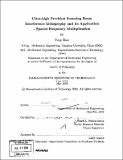| dc.contributor.advisor | Mark L. Schattenburg. | en_US |
| dc.contributor.author | Zhao, Yong, 1980- | en_US |
| dc.contributor.other | Massachusetts Institute of Technology. Dept. of Mechanical Engineering. | en_US |
| dc.date.accessioned | 2009-03-16T19:39:13Z | |
| dc.date.available | 2009-03-16T19:39:13Z | |
| dc.date.copyright | 2008 | en_US |
| dc.date.issued | 2008 | en_US |
| dc.identifier.uri | http://hdl.handle.net/1721.1/44756 | |
| dc.description | Thesis (Ph. D.)--Massachusetts Institute of Technology, Dept. of Mechanical Engineering, 2008. | en_US |
| dc.description | Includes bibliographical references (p. 135-138). | en_US |
| dc.description.abstract | Scanning beam interference lithography (SBIL) is a technique developed at MIT in 2003. The SBIL system, referred to as the Nanoruler, could fabricate grating patterns with around ten-nanometer phase repeatability. There were many factors which limit its precision and thus limit its utility for applications which require more precise phase control. In this thesis the main sources of error impairing the Nanoruler's patterning precision, which include thermal error of the environmental enclosure and the measurement error of a critical mirror in the stage interferometry system, have been identified. A digital PI-lead compensation controller has been designed to improve the air temperature stability of the environmental enclosure. A digital low-pass filter is utilized to reduce high spatial-frequency noise in the stage mirror non-flatness measurement. A factor that causes another kind of the mirror measurement error, which is an apparent location-dependent mirror non-flatness measurement, has been determined. A corresponding solution is developed to reduce this kind of error. Afterwards, as an application of ultra-high precision patterning, multiple-exposure SBIL is utilized to multiply the spatial frequency of patterns over large areas. The high nonlinearity of photo resists and the excellent pattern repeatability of the Nanoruler enable higher line densities to be achieved by applying a nonlinear process (development) between exposures of the Nanoruler. A phase control technique for accurately overlaying interference lithography exposures has been developed. Accurate phase control over large areas during spatial frequency multiplication by utilizing a surrounding alignment grating has been achieved. Three key factors- the angle, period, and phase of the alignment grating- have been accurately measured and utilized to position subsequent patterns with respect to previous patterns. | en_US |
| dc.description.abstract | (cont.) Some factors that can dramatically diminish the accuracy of phase control, such as particle-induced substrate distortion and nonlinear distortion of the alignment grating, have also been considered and minimized in order to improve the accuracy of phase control. For spatial frequency doubling with a 574 nm principal pitch, we achieved overlay phase errors with a mean of -1.0 nm ± 2.8nm(la) between overlaid grating patterns over a 25 x 32.5 mm2 area. Utilizing the same technique, we fabricated 50 nm-pitch gratings with spatial frequency quadrupling starting from a principal pitch of 200 nm. | en_US |
| dc.description.statementofresponsibility | by Yong Zhao. | en_US |
| dc.format.extent | 138 p. | en_US |
| dc.language.iso | eng | en_US |
| dc.publisher | Massachusetts Institute of Technology | en_US |
| dc.rights | M.I.T. theses are protected by
copyright. They may be viewed from this source for any purpose, but
reproduction or distribution in any format is prohibited without written
permission. See provided URL for inquiries about permission. | en_US |
| dc.rights.uri | http://dspace.mit.edu/handle/1721.1/7582 | en_US |
| dc.subject | Mechanical Engineering. | en_US |
| dc.title | Ultra-high precision scanning beam interference lithography and its application : spatial frequency multiplication | en_US |
| dc.title.alternative | Ultra-high precision SBIL and its application : spatial frequency multiplication | en_US |
| dc.type | Thesis | en_US |
| dc.description.degree | Ph.D. | en_US |
| dc.contributor.department | Massachusetts Institute of Technology. Department of Mechanical Engineering | |
| dc.identifier.oclc | 298862434 | en_US |
